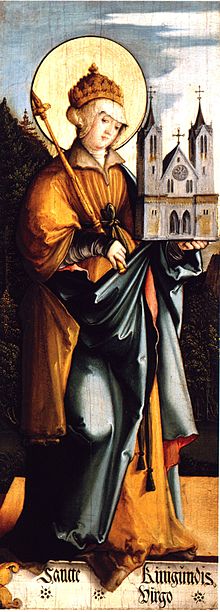Cunigunde of Luxembourg
| Saint Cunigunde of Luxembourg, OSB | |
|---|---|

Saint Cunigunda; painting by the Master of Meßkirch, c.1535/40, housed at the Staatsgalerie Stuttgart.
|
|
| Empress Consort and (later) Regent of the Holy Roman Empire | |
| Born | c. 975 |
| Died | 3 March 1040 |
| Venerated in | Roman Catholic Church |
| Canonized | 29 March 1200, Rome by Pope Innocent III |
| Major shrine | Bamberg Cathedral, Bamberg, Germany |
| Feast | 3 March |
| Attributes | An empress in imperial robes, sometimes holding a church. |
| Patronage | Patroness of Luxembourg, Lithuania, Poland, and the Archdiocese of Bamberg, Germany |
Saint Cunigunde of Luxembourg, OSB (c. 975 – 3 March 1040 at Kaufungen), also called Cunegundes, Cunegunda, and Cunegonda and, in Latin, Cunegundis or Kinigundis, was Empress of the Holy Roman Empire by marriage to Holy Roman Emperor Saint Henry II, and a Catholic Saint. She served as interim Regent after the death of her spouse in 1024. She is a Roman Catholic saint and the Patroness of Luxembourg and Lithuania; her feast day is 3 March.
St. Cunigunde was one of eleven children born to Siegfried I of Luxembourg (922 – 15 August 998) and Hedwig of Nordgau (c. 935 – 992). She was a seventh-generation descendant of Charlemagne. She married St. King Henry in 999. It is said that she had long wanted to be a nun, and that her marriage to St. Henry II was a spiritual one (also called a "white marriage"); that is, they married for companionship alone, and by mutual agreement did not consummate their relationship. It has been claimed that Cunigunde made a vow of virginity with Henry's consent prior to their marriage. The truth of this is debatable; while the couple were both certainly childless, it is supposed by some authors that later hagiographers mistakenly construed the fact to imply a virginal marriage. Others, however, accept that the marriage was purely platonic.
During their marriage, her husband, Henry, then only Duke of Bavaria, was crowned as King of Germany ("Rex Romanorum") on 9 July 1002 in Mainz, in present-day Germany, by Willigis, Archbishop of Mainz. After her husband was crowned as King of Germany, she was crowned as his Queen (consort) of Germany on 10 August 1002 in Paderborn, in present-day Germany, also by Willigis, Archbishop of Mainz. Later her husband was also crowned as King of Italy ("Rex Italiae") on 14 or 15 May 1004 in Pavia, Italy, but no evidence has been given of her being crowned as his queen consort of Italy.
...
Wikipedia
